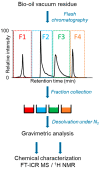Next Challenges for the Comprehensive Molecular Characterization of Complex Organic Mixtures in the Field of Sustainable Energy
- PMID: 36558021
- PMCID: PMC9786309
- DOI: 10.3390/molecules27248889
Next Challenges for the Comprehensive Molecular Characterization of Complex Organic Mixtures in the Field of Sustainable Energy
Abstract
The conversion of lignocellulosic biomass by pyrolysis or hydrothermal liquefaction gives access to a wide variety of molecules that can be used as fuel or as building blocks in the chemical industry. For such purposes, it is necessary to obtain their detailed chemical composition to adapt the conversion process, including the upgrading steps. Petroleomics has emerged as an integral approach to cover a missing link in the investigation bio-oils and linked products. It relies on ultra-high-resolution mass spectrometry to attempt to unravel the contribution of many compounds in complex samples by a non-targeted approach. The most recent developments in petroleomics partially alter the discriminating nature of the non-targeted analyses. However, a peak referring to one chemical formula possibly hides a forest of isomeric compounds, which may present a large chemical diversity concerning the nature of the chemical functions. This identification of chemical functions is essential in the context of the upgrading of bio-oils. The latest developments dedicated to this analytical challenge will be reviewed and discussed, particularly by integrating ion source features and incorporating new steps in the analytical workflow. The representativeness of the data obtained by the petroleomic approach is still an important issue.
Keywords: bio-oil; derivatization; fractionation; high-resolution mass spectrometry; ion mobility; tandem mass spectrometry.
Conflict of interest statement
The authors declare no conflict of interest.
Figures









References
-
- Statistical Review of World Energy. [(accessed on 29 November 2022)]. Available online: https://www.bp.com/content/dam/bp/business-sites/en/global/corporate/pdf....
-
- Altgelt K.H. Composition and Analysis of Heavy Petroleum Fractions. CRC Press; Boca Raton, FL, USA: 2016.
-
- Hunt J.M. Petroleum Geochemistry and Geology. 2nd ed. W.H. Freeman; New York, NY, USA: 1996.
-
- Kumar R., Strezov V., Weldekidan H., He J., Singh S., Kan T., Dastjerdi B. Lignocellulose Biomass Pyrolysis for Bio-Oil Production: A Review of Biomass Pre-Treatment Methods for Production of Drop-in Fuels. Renew. Sustain. Energy Rev. 2020;123:109763. doi: 10.1016/j.rser.2020.109763. - DOI
Publication types
MeSH terms
Substances
LinkOut - more resources
Full Text Sources

